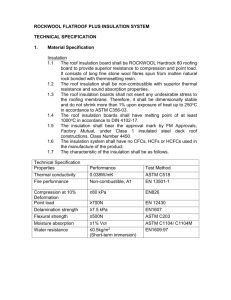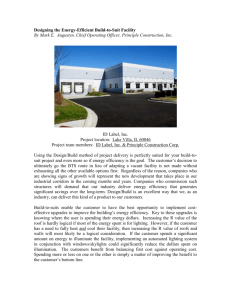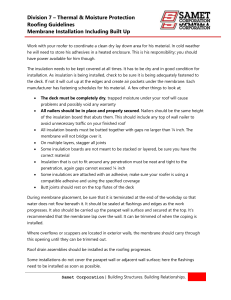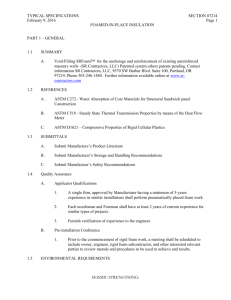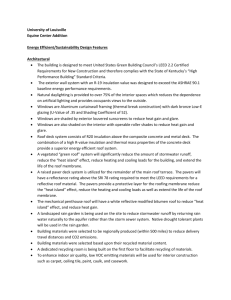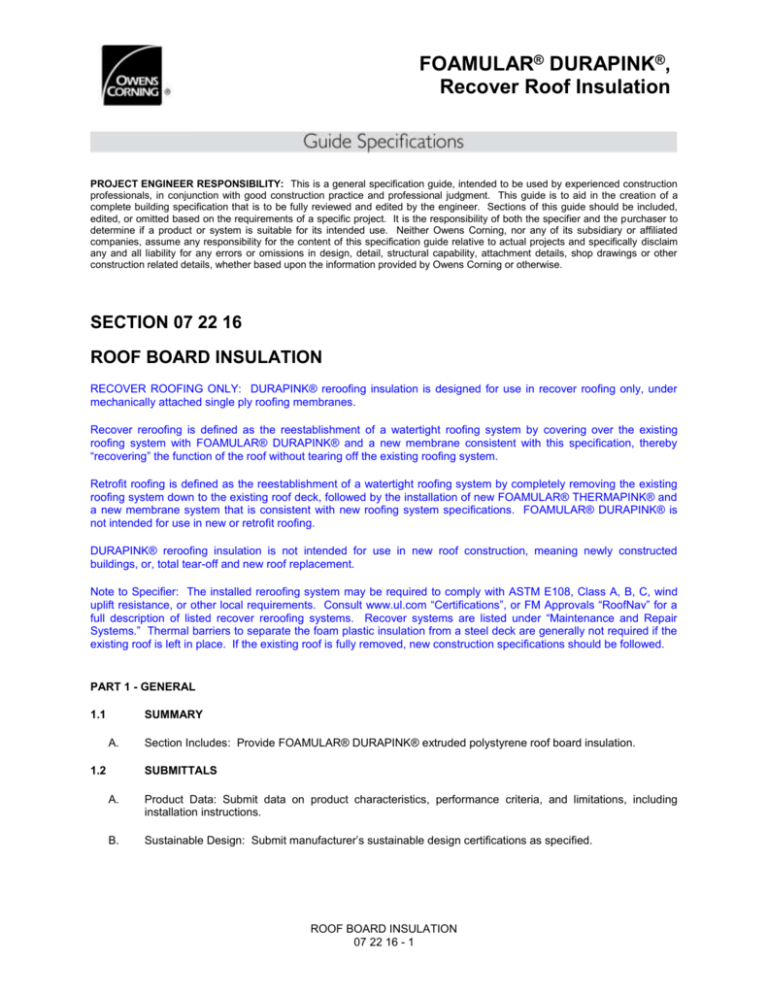
FOAMULAR® DURAPINK®,
Recover Roof Insulation
PROJECT ENGINEER RESPONSIBILITY: This is a general specification guide, intended to be used by experienced construction
professionals, in conjunction with good construction practice and professional judgment. This guide is to aid in the creation of a
complete building specification that is to be fully reviewed and edited by the engineer. Sections of this guide should be included,
edited, or omitted based on the requirements of a specific project. It is the responsibility of both the specifier and the purchaser to
determine if a product or system is suitable for its intended use. Neither Owens Corning, nor any of its subsidiary or affiliated
companies, assume any responsibility for the content of this specification guide relative to actual projects and specifically disclaim
any and all liability for any errors or omissions in design, detail, structural capability, attachment details, shop drawings or other
construction related details, whether based upon the information provided by Owens Corning or otherwise.
SECTION 07 22 16
ROOF BOARD INSULATION
RECOVER ROOFING ONLY: DURAPINK® reroofing insulation is designed for use in recover roofing only, under
mechanically attached single ply roofing membranes.
Recover reroofing is defined as the reestablishment of a watertight roofing system by covering over the existing
roofing system with FOAMULAR® DURAPINK® and a new membrane consistent with this specification, thereby
“recovering” the function of the roof without tearing off the existing roofing system.
Retrofit roofing is defined as the reestablishment of a watertight roofing system by completely removing the existing
roofing system down to the existing roof deck, followed by the installation of new FOAMULAR® THERMAPINK® and
a new membrane system that is consistent with new roofing system specifications. FOAMULAR® DURAPINK® is
not intended for use in new or retrofit roofing.
DURAPINK® reroofing insulation is not intended for use in new roof construction, meaning newly constructed
buildings, or, total tear-off and new roof replacement.
Note to Specifier: The installed reroofing system may be required to comply with ASTM E108, Class A, B, C, wind
uplift resistance, or other local requirements. Consult www.ul.com “Certifications”, or FM Approvals “RoofNav” for a
full description of listed recover reroofing systems. Recover systems are listed under “Maintenance and Repair
Systems.” Thermal barriers to separate the foam plastic insulation from a steel deck are generally not required if the
existing roof is left in place. If the existing roof is fully removed, new construction specifications should be followed.
PART 1 - GENERAL
1.1
SUMMARY
A.
1.2
Section Includes: Provide FOAMULAR® DURAPINK® extruded polystyrene roof board insulation.
SUBMITTALS
A.
Product Data: Submit data on product characteristics, performance criteria, and limitations, including
installation instructions.
B.
Sustainable Design: Submit manufacturer’s sustainable design certifications as specified.
ROOF BOARD INSULATION
07 22 16 - 1
FOAMULAR® DURAPINK®,
Recover Roof Insulation
1.3
QUALITY ASSURANCE
A.
Installer Qualifications: The installation work of this Section shall be performed by an experienced roofing
contractor approved and certified by the roofing system manufacturer.
B.
Each insulation board must be labeled with manufacturer's name, product brand name, ASTM material
specification reference, and identification of the third party inspection agency used for building code
qualification.
1.4
DELIVERY, STORAGE, AND HANDLING
A.
Deliver materials in manufacturer’s original packaging.
B.
Store and protect products in accordance with manufacturer’s instructions. Store in a dry area and protect
from water, direct sunlight, flame, and ignition sources. Do not install insulation that has been damaged or
wet.
1.
In the event the board insulation becomes wet, wipe dry prior to installation.
Note to Specifier: For proper fire protection of plastic foam in storage, consult the National Fire Protection
Association (NFPA) standards or the authority having jurisdiction.
1.5
PROJECT CONDITIONS
A.
Only single layer application permitted. All thicknesses of DURAPINK® insulation are to be used in a
single layer application only. DURAPINK® insulation shall not be installed as a cover board over a layer,
or layers, of FOAMULAR®, THERMAPINK® or other type of insulation being installed concurrently with
the DURAPINK® or left in place after tear off of an existing membrane.
B.
Limitations on recovered insulation: DURAPINK® insulation, all thicknesses, shall not be installed over
existing roofing systems that have more than 3” of insulation in place or a thermal resistance greater than
R-17.
C.
Existing roof surface shall be free of ponded water, ice or snow. This precaution is to discourage potential
future condensation on the underside of the retrofit membrane.
D.
Do not expose DURAPINK® insulation to surfaces such as pipes, vent stacks or other rooftop
appurtenances whose constant temperature is in excess of 165°F. Exposure to the temperature under
black single ply membranes is acceptable. Cyclical temperature at the insulation/membrane interface is
anticipated to be approximately 195°F under dark single ply membranes. DURAPINK® insulation should
not be exposed to 195°F simultaneously on all surfaces.
E.
When insulation will be exposed to sunlight for prolonged periods due to job site delays, protect the
insulation with a light colored opaque covering. Provisions should be made to prevent wind loss of
insulation materials at the job site when partially open units of DURAPINK® insulation are on hand.
F.
Roofs exposed to chemical discharge, or reflective vertical surfaces adjacent to the roof, require special
consideration. Consult an Owens Corning representative for recommendations regarding system
components.
G.
[Repair or replace deteriorated decking. Verify that existing roof drains are open and adequate to promote
proper roof drainage.]
ROOF BOARD INSULATION
07 22 16 - 2
FOAMULAR® DURAPINK®,
Recover Roof Insulation
1.6
WARRANTY
A.
A thermal performance warranty shall be issued to the project owner upon completion of the work.
[Insulation shall be warranted to retain a minimum of 90% of its published R-value and complete other
ASTM C578 phyiscal properties for the building lifetime.] [A single source roof system warranty shall be
issued to the project owner upon completion of the work.]
PART 2 - PRODUCTS
2.1
MANUFACTURER
A.
2.2
Owens Corning Insulating Systems, LLC, Toledo, OH 43659; www.owenscorning.com.
MATERIALS
A.
Extruded Polystyrene Insulation:
1.
Physical Properties: DURAPINK® extruded polystyrene (XPS) closed-cell foam panel, unfaced,
with as manufactured surfaces, conforming to the minimum physical requirements of ASTM C-578,
[Type X for 1/2”, Type IV for 3/4”, 1"].
Note to Specifier: See the Product Data Sheets for DURAPINK® product physical properties and association with
ASTM C578 type designations. No further specification of physical properties is required if a standard ASTM C578
type designation is given. However, if the specifier chooses to elaborate, it should be verified that the specified
properties align with the chosen ASTM type category.
2.
Product Criteria:
a.
ASTM C578 type [X, IV], certified by independent third party such as RADCO.
b.
Blowing Agent Formulation: Zero ozone depleting.
c.
Compressive Strength (ASTM D 1621): [15, 25] psi, minimum.
d.
Edge Condition: Square edge.
e.
Thermal Resistance (180 day real-time aging as mandated by ASTM C578, measured per
ASTM C 518 at mean temperature of 75oF): 5.0 per inch of thickness, with 90% lifetime
limited warranty on thermal resistance.
f.
Surface Burning Characteristics (ASTM E 84): Flame spread less than 25, smoke
developed less than 450, certified by independent third party such as Underwriters
Laboratories.
g.
Indoor Air Quality: Compliance certified by independent third party such as GREENGUARD
Indoor Air Quality Certified® and/or GREENGUARD Children and Schools Certified℠.
h.
Recycle Content: Minimum 20%, certified by independent third party such as Scientific
Certification Systems.
i.
Warranty: Limited lifetime warranty covering all ASTM C578 physical properties.
3.
Manufacturers: Subject to compliance with product criteria, the manufacturers whose products may
be incorporated into the work include but are not limited to:
a.
DiversiFoam Products.
b.
Dow Chemical Company.
c.
Owens Corning.
d.
Pactiv Corporation.
4.
Panel Size: Provide [1/2”, 3/4”, 1”] thick by 4 ft. wide by 8 ft. long.
Note to Specifier: Include the following, if required for mechanically attached systems:
B.
[Insulation Fasteners and Stress Plates]: Furnished by membrane manufacturer. FM approved. Fastener
head shall be designed to inhibit damage to the membrane. Minimum 3" diameter or square insulation
stress plates shall provide for countersunk fastener heads.
ROOF BOARD INSULATION
07 22 16 - 3
FOAMULAR® DURAPINK®,
Recover Roof Insulation
Note to Specifier: Consult local building code enforcement authorities. Generally recover roofing over an existing roof
will not require the installation of a new thermal barrier because the existing roof serves as adequate separation from
an existing steel roof deck. This is a consideration for steel decks only; thermal barriers are not needed for other
deck types.
C.
[Thermal Barrier Material]: Provide one of the following:
1.
Gypsum Board: 1/2" (minimum thickness)
2.
Rigid Perlite Board: 1/2" (minimum thickness).
Note to Specifier: Any separator sheet shall have been evaluated and approved by the membrane manufacturer for
adequacy as a separator. In all cases the membrane manufacturer's recommendation regarding insulation
overlayment shall prevail. Overlayment protection for chemical separation is not required when DURAPINK®
insulation is used in conjunction with black or white EPDM, TPO, or most thermoplastic single ply membranes.
DURAPINK® insulation used in Class A, B or C (ASTM E 108) fire rated recover roofing, or, used under PVC or other
thermoplastic membranes which contain plasticizing agents DO require separation from polystyrene. If a loose
separator sheet is required, and appropriately fire tested, or approved by the membrane manufacturer, use sheets
such as fire rated glass fiber mat. Requirements for overlayment materials and weights may vary. Contact the
membrane manufacturer and consult www.ul.com “Certifications” and FM Approvals “RoofNav” for their individual
requirements.
D.
[Separator Sheet:] Provide as required by membrane manufacturer a flexible glass fiber, nonwoven, nonflammable, corrosion and mildew resistant or other suitable separator (overlayment) sheet.
E.
Membrane Fastening or Adhesion System: Per membrane manufacturer’s specifications.
PART 3 - EXECUTION
3.1
EXISTING ROOF SURFACE EVALUATION AND PREPARATION
A.
Fire rating of the recover roofing system must comply with local building code requirements. All existing
roof coverings over which roof board insulation is to be placed must be evaluated for compliance with
applicable building code requirements for roof fire classification. roof board insulation products may be
placed directly on top of the existing roof covering. Loose gravel ballast may be removed to provide a
clean substrate for insulation application; however, the final fire rating may be affected. Check roofing
system fire rating listings to determine if fire rating will be affected if gravel is removed.
B.
The existing roof surface shall be prepared to provide adequate support for the roof board insulation. roof
board insulation products are capable of conforming to modest irregularities in the existing surface without
breaking. The roof deck should be examined for old equipment curbs, lumps of gravel or asphalt or other
irregularities or debris which could affect the integrity or levelness of the new insulation layer. Conditions
considered unacceptable by the membrane manufacturer or specifier should be corrected.
C.
Evaluate existing roof covering over which roof board insulation is to be applied for moisture content.
Existing roof surface shall be free of ponded water, ice or snow. This precaution is to discourage potential
future condensation on the underside of the recover roofing membrane. Although roof board insulation
products are hydrophobic and are unharmed by the presence of moisture, long term entrapped moisture
within the existing roof system can promote corrosion of the roof deck and mechanical fasteners.
D.
All existing roof structures over which roof board insulation is to be applied shall be evaluated for the
necessary structural dead load carrying capacity to accommodate the minimal additional dead load of the
recover roofing system. The entire recover roofing system including roof board insulation, possible a
separator sheet and single-ply membrane, is not likely to weigh more than 1.0 psf.
ROOF BOARD INSULATION
07 22 16 - 4
FOAMULAR® DURAPINK®,
Recover Roof Insulation
E.
[Place an impervious separator sheet, such as 6 mil polyethylene, between coal-tar BUR and roof board
insulation.] This is required only if the existing coal-tar BUR is less than ten years old in a northern
environment or less than seven years old in a southern environment, or has been re-saturated or patched
in the last four years.
F.
Any deteriorated roof decking shall be repaired or replaced before installing the recover roofing system.
G.
Verify that existing roof drains are adequate, open and are properly functioning before installing the
recover roofing system.
3.2
EXISTING VAPOR RETARDER
A.
3.3
[Existing vapor retarder must be perforated at the rate of [_____square inches per square foot].] The
presence of an existing vapor retarder may slow the drying rate of a moderately wet recovered roof,
making total dry out time longer. See the American Society of Heating, Refrigerating and Air Conditioning
Engineers (ASHRAE) Handbook of Fundamentals for specific design guidelines.
INSULATION
A.
Apply only as much roof insulation as can be covered by the roofing membrane on the same day.
B.
Apply insulation in parallel rows, perpendicular to membrane seams [if possible.] with end joints staggered.
See the note following this paragraph. Install side and end joints closely but do not force together. Some
contractors and membrane manufacturers prefer that the long dimension of the insulation board be
installed parallel with the membrane seams, thereby avoiding a "sawtooth edge" when preparing overnight
seals or beginning the next roll of membrane. Installation perpendicular to membrane seams is only a
suggestion to increase the probability of more membrane fasteners crossing any given board. This
requirement can be waived if necessary.
C.
Place the insulation board with the printed logo surface down so that the black lettering is not exposed to
potential solar heat gain.
D.
In areas where black/dark membranes are used and where "reflected solar energy" is expected to be
present, the roof board insulation need additonal protection. For example, roof areas adjacent to higher
walls, particularly walls with reflective surfaces, or near large rooftop HVAC units, or near or in between
clusters of mechanical equipment, or near other structures with reflective cladding (metal or glass); or near
higher reflective parapets, all such areas should be considered for additional heat protection. Such roof
areas must be covered with pavers or ballast or black/dark (non-white) membranes must be coated with
white reflective topping, and maintained white, to avoid damage due to the intensified heat exposure from
reflected sun in such areas.
E.
Insulation joints as installed shall not exceed 1/4” in width. Joints wider than 1/4” shall corrected by filling
with like material.
F.
Insulation shall be field trimmed to fit tightly around roof protrusions and terminations.
G.
Mechanical fasteners shall be of sufficient number and appropriate pattern to resist wind uplift forces.
Fastening patterns shall be as specified for the appropriate system from Table A.
H.
[Mechanical fastening of insulation and loose separator sheet, if any, may coincide so that fastener
penetrates the sheet, then through the roof board insulation into the structural substrate a minimum
distance as required by the fastener manufacturer.]
ROOF BOARD INSULATION
07 22 16 - 5
FOAMULAR® DURAPINK®,
Recover Roof Insulation
3.4
[OVERLAYMENT/SEPARATOR SHEETS]
A.
[Loose lay flexible sheet overlayment over roof board insulation and cover with a membrane attached per
the manufacturer’s recommendations. Edges and ends of rolls shall be lapped a minimum of 6". Only dry
overlayment materials shall be used. If overlayment materials become wet, allow them to fully dry before
proceeding with roofing application.] Overlayment protection is not required when roof board insulation is
used in conjunction with black or white EPDM, TPO, or most thermoplastic single ply membranes. A
separator sheet approved by the membrane manufacturer such as a fire rated glass fiber mat must be
used to separate the insulation layer when an ASTM E 108 Class A, B, ro C fire rating is required, or, to
separate the insulation from PVC and other thermoplastic membranes which contain plasticizing agents.
Requirements for overlayment materials and weights may vary. Contact membrane manufacturer for their
individual requirements.
B.
When cleaning agents and seam adhesives used are solvent based and capable of causing cavitation of
the underlying roof board insulation, use care when preparing membrane edges for in field seam splicing.
3.5
3.6
MECHANICAL FASTENERS
A.
Fastener/stress plate assemblies shall be driven to tightly secure the insulation board and seat the plate
but shall not be overdriven so that the insulation board is crushed beneath the plate. Fasteners which are
improperly installed shall be removed or corrected. Improper installation may include overdriving such that
the stress plate is concave and cuts a significant depression in the insulation; underdriving such that the
fastener head is not properly seated in the stress plate and may puncture the membrane; broken or bent
shanks; improper location; or insufficient length.
B.
Fasteners shall be embedded in the deck per manufacturer’s recommendations to insure adequate
withdrawal resistance.
FASTENING PATTERNS, TABLE A
System
Insulation
Thickness
Black (dark) Membranes,
Mechanically Attached,
(w/wind rating per membrane specs.)
White Membranes,
Mechanically Attached,
(w/wind rating per membrane specs.)
DURAPINK®
1/2”, 3/4”, 1”
Fasteners
(per 4x8)
8
Fastening
Pattern
B
DURAPINK®
1/2”, 3/4”, 1”
4
C
(with separator
sheet, as required)
Off white or other light color Membranes,
DURAPINK®
1/2”, 3/4”, 1”
6
F
Mechanically Attached,
(with separator
(w/wind rating per membrane specs.)
sheet, as required)
1.
Note: Recover roofing surfaces are often uneven. For patterns C and F, although sufficient to to
secure DURAPINK® insulation, additonal fasteners installed per pattern A will cause the board to
lay flatter in service.
END OF SECTION
Pub No 10019388 © 2014 Owens Corning. All Rights Reserved.
ROOF BOARD INSULATION
07 22 16 - 6


